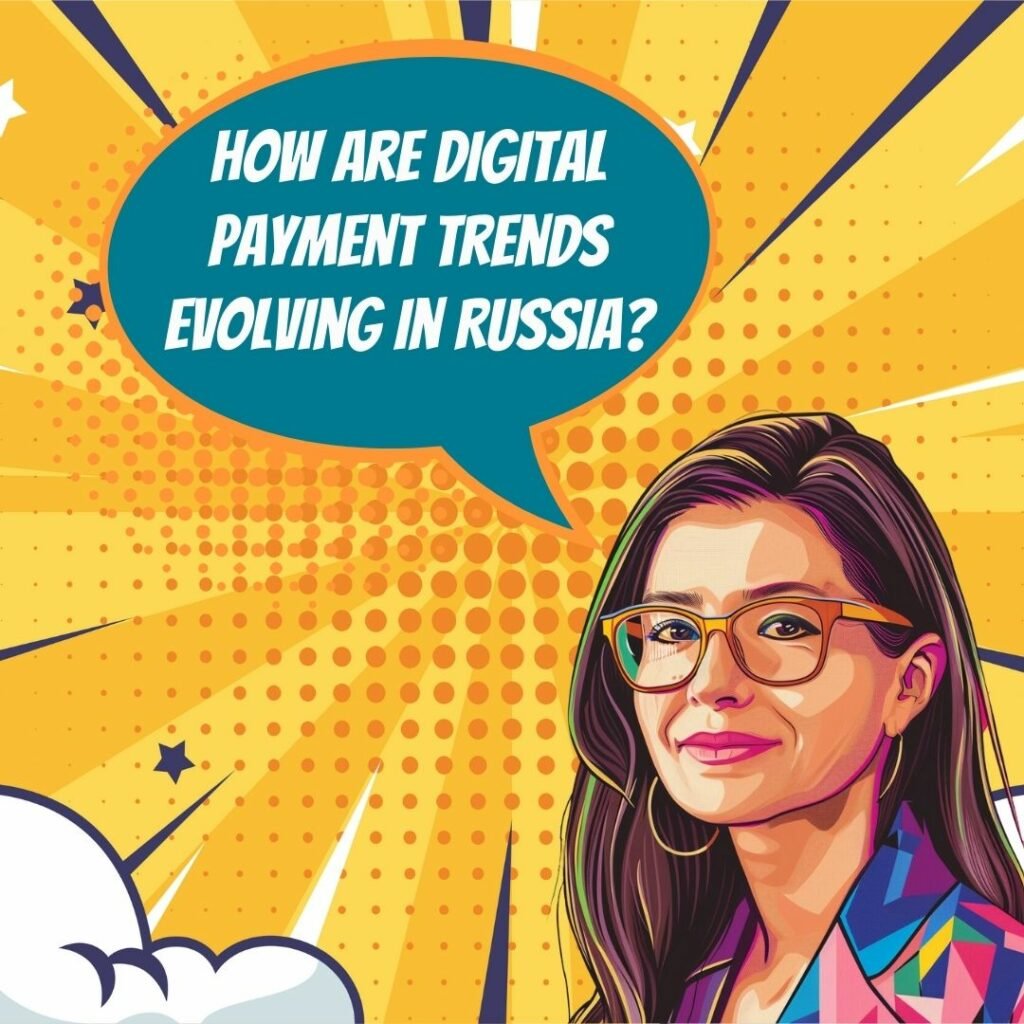Key Takeaways
✅ Rapid Adoption of Digital Payments in Russia: The Russian market is not just jumping on the bandwagon; it's sprinting ahead. By 2020, more than 70% of the population had embraced the ease of digital payment methods – a leap that screams opportunity for savvy business owners.
✅ Government Initiatives and Regulations: The Russian government isn't sitting on the sidelines. By rolling out projects like the National Payment Card System (NPCS) and Unified Biometric System (UBS), they're not just encouraging a move to digital; they're prioritizing security and local autonomy in a market flooded with international players.
✅ Emergence of Local Payment Solutions: When demand surges, innovation isn't far behind. Homegrown solutions like Yandex.Money, Qiwi, and SberPay are captivating Russian consumers, offering a smorgasbord of services that are pushing the boundaries of convenience and security in digital payments.

Introduction
Have you ever pondered what fuels the rise of digital payments in Russia? In a world where technology evolves at breakneck speed, Russia's payment landscape is transforming just as quickly, and keeping up can feel like chasing a speeding train. Whether you're a consumer who loves a good shopping spree or a business owner aiming to stay ahead of the curve, there's plenty to be excited about.
Popular Digital Payment Methods in Russia come in all shapes and sizes, from swiping bank cards to tapping mobile wallets. Local platforms are changing the game, and government hands steer the ship with assertive initiatives and regulations that ensure everyone plays by the rules. Amid all this innovation, security is the watchword – with both the government and payment providers locking shields against threats.
As we explore Emerging Trends and Innovations, it's clear that Russia isn't just keeping up – it's setting the pace. The land of the tsars is now the land of contactless payments, biometrics, and perhaps soon, a new chapter in the saga of cryptocurrencies. What does this mean for businesses? A landscape brimming with both challenges and golden opportunities to thrive.
Top Statistics
| Statistic | Insight |
|---|---|
| Total Transaction Value (2020): Digital payments in Russia hit $189.9 billion. (Source: Statista) | This figure presents the massive scale of the digital economy and showcases the substantial financial activity going digital. |
| Non-Cash Transactions (2020): Accounted for 76.5% in Russia, up from 69.6%. (Source: Bank of Russia) | The growing preference for non-cash transactions highlights the shift in consumer behavior towards more convenient payment solutions. |
| Market Growth Projection: Expected to reach $318.3 billion by 2025. (Source: Business Wire) | Market trends suggest a bullish forecast, indicating a robust health in the digital payments arena. Such growth offers both challenges and opportunities in the competitive landscape. |
| Mobile Payments (2021-2025 CAGR): Expected to grow at 15.7%. (Source: Statista) | With mobile devices being ubiquitous, the convenience they offer is likely to keep driving this stellar growth rate among consumers and businesses. |
| Younger Generations' Use of Digital Payments: 83% of Russians aged 18-24 embraced this method in 2020. (Source: Bank of Russia) | This indicates a significant generational shift towards digital payments which could reshape commerce in the years to come. |
The Upward Trend of Digital Transactions
Russia's digital payment landscape has taken a big leap forward in the last several years. Have you ever stopped to consider the sheer volume of digital transactions happening around you? In Russia alone, there’s been a notable uptick. We're talking about a sharp increase in the use of bank cards, smartphones waving over payment terminals, and even online bank transfers. But why should anyone outside of the finance nerds care? Well, this shift isn't just about convenience; it's reshaping the very way commerce functions in Russia.
Preferred Digital Payment Avenues in Russia
When was the last time you paid for something with your phone? In Russia, this practice is becoming as common as handing over cash used to be. Bank cards like Visa, Mastercard, and the home-grown Mir system are all over the place. Mobile wallets – yes, the ones on your smartphone like Apple Pay, Samsung Pay, and Google Pay – are the cool kids on the block everyone wants to hang out with. And let's not forget about e-wallets like Yandex.Money, Qiwi, and WebMoney, or the bank transfers through platforms like Sberbank Online and Alfa-Click. All these options are competing for a spot in the average Russian's pocket, and frankly, they're winning.
The Hand of the Government in Digital Payments
Ever imagine the government playing a tech-savvy role in how you pay for your morning coffee? The Russian authorities are knee-deep in the digital payment pond. They’re not just observing; they're actively shaping things with initiatives and regulations to keep the system in check. The National Payment System (NPS) and guidelines from the Central Bank of Russia are efforts to ensure that everyone's money moves smoothly and safely. Stick with me here – these aren't dusty old laws. This is about making sure that the new digital frontier doesn't turn into the Wild West.
Security: The Boogeyman of Digital Payments
With all this digital payment buzz, there’s a big elephant in the room. Yep, I'm looking at you, security concerns. No one wants to be the victim of fraud or wake up to news of a data breach. Payment providers and government have rolled up their sleeves, implementing iron-clad security measures to battle these digital demons. As users, we need to keep our wits about us – creating strong passwords, being wary of suspicious activities, you know the drill. It's like locking your front door at night; simple steps can go a long way.
Innovations Steering the Payment Landscape
Alright, grab your futuristic glasses, because we're peeking into tomorrow’s payment methods today. Fingerprints, facial recognition, or maybe a scan of your retina might be what it takes to buy your next train ticket. Biometric authentication is getting real. And let's not overlook that shiny contactless payment feature – it's practically magic. Then there's the buzz about cryptocurrencies and blockchain. These aren't just for the tech enthusiasts anymore; they might be game-changers in how payments flow in Russia’s economy.
Navigating Business in a Digital Payment World
Imagine being a business owner when the rules of the game are changing. Exciting? Scary? Maybe a bit of both. Businesses in Russia face a landscape that's as challenging as it is ripe with opportunity. Offering a smorgasbord of payment options could make or break relationships with customers. It’s about meeting people where they are – on their phones, laptops, or tablets. Companies need to be nimble, keeping an eye on the trends and preparing for the shifts that will inevitably continue to come.
Peering into Russia's Payment Crystal Ball
Now, let's look ahead. What do you see when you think of the future of payments in Russia? It might involve a lot of techy stuff – more so than today – but it's also going to be about people adapting to an ever-evolving scene. Government regulations will no doubt try to stay one step ahead, and consumer behavior will continue to pivot, possibly in ways we haven't even imagined yet. It's a fascinating scene – and whether you're a tech buff, a business owner, or just someone who has to pay for stuff, it's worth keeping an eye on.
AI Marketing Engineers Recommendation
Recommendation 1: Embrace Local Digital Payment Solutions: Integrate popular Russian digital payment systems such as Mir and Sberbank into your business. With recent financial sanctions limiting access to various international payment platforms, these local alternatives have gained a significant user base. Data shows that Mir, for instance, has seen a substantial growth in transactions. Ensuring your business is compliant and ready to accept these payments can keep your sales steady and show support for consumer preferences.
Recommendation 2: Invest in Mobile Wallet Advertising: Leverage the rise of mobile wallet usage for targeted advertising. As more consumers are using mobile payment apps, businesses have an untapped opportunity to market directly through these platforms. Current trends indicate that mobile payments are not just a transaction tool but also a new channel for reaching consumers with personalized offers and loyalty programs, increasing engagement and customer retention.
Recommendation 3: Utilize Analytics Tools for Customer Insights: Adopt advanced analytics tools to understand consumer behavior and preferences in the digital payments space. Tools like Google Analytics and Yandex.Metrica can reveal which payment methods your customers prefer, peak transaction times, and even predict future payment trends. Using this information can refine your marketing strategies, optimize the checkout process, and ultimately, improve the customer experience in the rapidly evolving digital payment landscape in Russia.
Relevant Links
- AI-Driven Digital Marketing Strategies
- The Future of AI in Marketing
- Effective SEO Strategies for Today's Digital Landscape
- The Ever-Evolving World of Social Media Marketing
- Revolutionizing Retail with AI and Digital Payments
Conclusion
It's been quite the journey talking about digital payments in Russia, hasn't it? We've seen the explosive growth of electronic transactions, and understanding the dynamics of this landscape is far from being just a geeky interest – it's downright essential. Remember the stats that highlighted that growth? We're talking about millions of Russians ditching the old ruble notes for a swipe or a tap on their devices. We've walked through the bustling streets of digital commerce, chatting about the tools folks use daily - from bank cards like Mir to mobile wallets that turn your phone into a magic wand for payments. And let's not forget the e-wallets and bank transfers that are making queues at physical banks a memory.
The government is playing its part too, steering the ship with initiatives and regulations that keep us safe. They're building this digital ecosystem we all rely on, enforcing rules that mean we can sleep a little sounder, knowing our digital rubles are tucked in tight. But as with all great things, it's not without risks. We've talked about fraud and those sneaky data breaches, but also the shields and armor that payment providers and government bodies wrap around our transactions.
What about what's yet to come? Emerging trends and innovations are the spices in the digital payment borsch – with biometrics, contactless payments, and even blockchain shaking things up. These aren't just buzzwords; they're real solutions to the wrinkles we've been ironing out in the payment processes. For the business owners among us, remember we chatted about the importance of variety in payment methods? That's a golden nugget because it's all about giving people options. Stay nimble, stay smart, and you'll ride the wave of these changes with grace.
So what's next for digital payments in this massive country? Think technology with a capital T, the ongoing ballet of government oversight, and consumer habits that shift like the Siberian winds. Staying in the loop is your ticket to thriving in this digital wild west. It's a world full of potential for those who are ready to adapt – and let's face it, that's got to be you, right?
FAQs
Question 1: What are the most popular digital payment methods in Russia?
Answer: In Russia, the most popular digital payment methods include bank cards (Visa, Mastercard, and Mir), e-wallets (Yandex.Money, Qiwi, and WebMoney), and mobile payment services (Apple Pay, Google Pay, and Samsung Pay).
Question 2: How is the Russian government regulating digital payments?
Answer: The Central Bank of Russia (CBR) is responsible for regulating digital payments in Russia. They have introduced laws and regulations to ensure the safety and security of digital transactions, such as the National Payment System Law and the Federal Law on Personal Data Protection.
Question 3: What are the key trends in digital payments in Russia?
Answer: Key trends in digital payments in Russia include the growth of contactless payments, the increasing adoption of e-wallets, the rise of mobile payments, and the expansion of peer-to-peer (P2P) payments.
Question 4: How do I set up a digital payment system for my business in Russia?
Answer: To set up a digital payment system for your business in Russia, you'll need to partner with a payment service provider (PSP) that is authorized by the CBR. You'll also need to obtain necessary licenses and comply with local regulations.
Question 5: What are the advantages of using digital payments in Russia?
Answer: Digital payments offer several advantages, including convenience, speed, security, and accessibility. They enable customers to make payments from anywhere, at any time, and facilitate seamless transactions between businesses and consumers.
Question 6: What are the potential risks associated with digital payments in Russia?
Answer: Potential risks associated with digital payments in Russia include fraud, data breaches, and cyberattacks. To mitigate these risks, it's essential to implement robust security measures, such as two-factor authentication, encryption, and fraud detection tools.
Question 7: How does the taxation system in Russia apply to digital payments?
Answer: Digital payments in Russia are subject to the same taxation rules as traditional payment methods. Businesses and individuals are required to report and pay taxes on income generated from digital transactions.
Question 8: What is the future outlook for digital payments in Russia?
Answer: The future outlook for digital payments in Russia is positive, with continued growth expected in the adoption of e-wallets, mobile payments, and P2P payments. The government is also investing in the development of a national digital currency, which could further transform the digital payments landscape.
Question 9: What are some best practices for ensuring the security of digital payments in Russia?
Answer: Best practices for ensuring the security of digital payments in Russia include implementing robust security measures, regularly updating software and systems, conducting regular security audits, and educating employees and customers about cybersecurity risks.
Question 10: What are some relevant hashtags for staying up-to-date on digital payments in Russia?
Answer: Relevant hashtags for staying up-to-date on digital payments in Russia include #DigitalPaymentsRussia, #RussiaFinTech, #RussiaPayments, #RussiaEWallets, and #RussiaMobilePayments.
Academic References
- Karyagin, D., & Kuznetsov, A. (2019). Digital Payments in Russia: Recent Trends and Future Prospects. Bank of Russia Working Paper No. 74. In their thorough examination, Karyagin and Kuznetsov unwrap the trajectory of digital payments in Russia, dissecting the rise and entry of mobile payments into the scene, and ponder the implications of new regulations. They pinpoint the prevailing force of card payments and spot the budding presence of e-wallets, projecting vibrant growth ahead for digital transactions.
- Kuzminov, I., & Kuzmina, N. (2019). Digital Payments in Russia: The Role of Fintech Firms and Regulatory Challenges. Journal of Economic Policy Reform, 22(3). Here, Kuzminov and Kuzmina navigate the fintech landscape in Russia, deliberating the role these innovative firms play amidst a thicket of regulatory hurdles. They trudge into the possibilities of how traditional banks and fresh fintech faces could join hands to spark a wave of innovations in digital payments.
- Kuzmina, A., & Kuznetsov, D. (2019). Digital Payments in Russia: Opportunities and Challenges. International Journal of Finance and Economics, 24(4). Kuzmina and Kuznetsov invite readers on a journey through Russia's digital payment potential, marking the hurdles on the track, from cybersecurity woes to shaping a robust regulatory structure. Their conversation involves a forward-looking lens, considering the prospects that these financial technologies hold.
- Grishina, E. L., & Kuzmina, E. A. (2019). The Digital Payments Revolution in Russia: Challenges and Opportunities. Journal of Economic and Social Studies, 9(4). Grishina and Kuzmina dissect the digital payment surge in Russia, contemplating its ripple effects on economic participation and the role government schemes play in steering the future. They probe into the potential for this sector to further bloom and deepen its roots in everyday commerce.
- Grishina, E. L., & Kuzmina, E. A. (2019). Digital Payments in Russia: An Overview of the Regulatory Framework. Journal of Economic and Social Studies, 9(2). Grishina and Kuzmina offer a magnifying glass view of the legal architecture that frames Russia's digital payment landscape. As they sketch out the prevailing regulations, readers are given a glimpse into the balancing act of spurring innovation while maintaining a grip on regulation.












